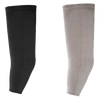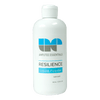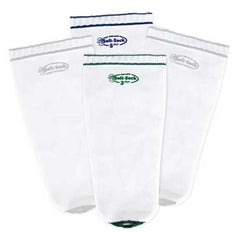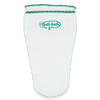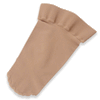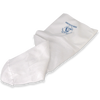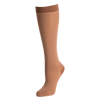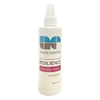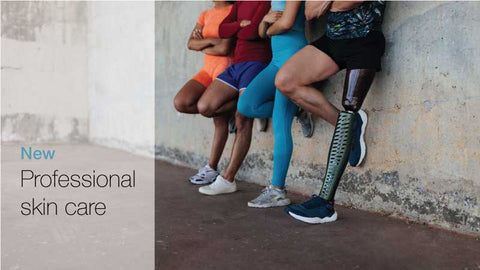Effective Ways to Soothe and Treat Chafing
Reading Time: 6 minutes
Chafing is a year-round issue, especially for those who wear prosthetic limbs. In summer, high temperatures and humidity increase sweating, leading to more friction and chafing. In winter, cold weather can cause dry skin, which is more prone to irritation and cracking when exposed to friction. So, it’s crucial to incorporate habits that prevent and manage chafing in your daily routine.

In this article, we explore common causes of chafing (besides wearing a prosthetic limb), treatment options, and prevention habits.
What is chafing?
Chafing is a common skin issue caused by a combination of friction, moisture, and irritating materials, like clothing or an ill-fitting prosthetic socket. When skin is subjected to continuous rubbing, it can lead to a stinging or burning sensation, often accompanied by a mild red rash. In more severe instances, chafing may result in swelling, bleeding, or crusted areas on the skin.
Certain areas of the body are more prone to chafing, especially those that come into contact with each other, like thighs and armpits, clothing, or prosthetic devices. Other common sites for chafing include the residual limb, groin, buttocks, and feet.
Common causes
Although the skin is resilient and flexible, excessive strain can lead to skin damage. Chafing typically develops from repeated rubbing, which becomes worse when combined with moisture. Several factors can contribute to chafing:
-
Improper prosthesis fit. A prosthetic socket that is too loose or too tight can create uneven pressure and movement, resulting in skin irritation.
-
Environmental conditions. High humidity or rainy weather can worsen chafing due to increased moisture levels.
-
Friction. Continuous rubbing between your skin and the prosthetic socket or liner can lead to irritation.
-
Moisture. Sweat build-up within a prosthetic socket can create a damp environment, increasing the risk of chafing.
-
Endurance sports. Activities such as adaptive biking or running, which combine sweat and repetitive motions, often lead to chafing. Athletes may experience chafing anywhere their skin, prosthetic, or clothing creates friction.
-
Ill-fitting clothing. Items like waistbands, sleeves, and bra straps that rub against the skin can cause irritation.
-
Excess weight. Being overweight can lead to increased skin-to-skin contact, particularly in areas like the arms and thighs. Excess weight also results in skin folds, which trap moisture and sweat.
How to treat chafed skin
Immediately stop activities that may be causing friction and irritation to your skin. At the first sign of chafing, remove your prosthetic limb or opt for loose-fitting clothing to alleviate discomfort. Then, clean the affected area with warm water and a gentle soap. Pat it dry.
Apply soothing products, such as balm, lotion, oil, or petroleum jelly. Choose items that are fragrance-free and designed to repel moisture for optimal healing. And avoid wearing your prosthetic limb for a few days to let your skin heal.
Recovery tips
Once the irritating factor is eliminated, chafing often resolves within a few days. If you cannot completely avoid the source of chafing, such as a prosthetic limb, consider using protective options, like prosthetic sheaths or liner patches. These can help create a barrier that protects the skin from friction.
However, it’s still beneficial to take a break from your prosthesis during recovery.
If the chafing is caused by the prosthetic socket fit, it’s best to seek guidance from your prosthetist.
As your skin is healing, it’s important to avoid the following:
-
Steer clear of bathing in hot water or using harsh soaps, as these can cause dryness and increase the risk of further irritation.
-
Avoid cleaning chafed areas with hydrogen peroxide or iodine, as these can impede healing. Instead, opt for a gentle cleanser, like a mild soap and water or a saline solution.
-
Always dry the skin gently by patting it, as rubbing can irritate the chafed area.
-
For pain relief, you can use ice or cold packs for 10 to 20 minutes at a time. Prolonged exposure can lead to further damage. And always place a barrier, like a towel or cloth, between the ice pack and your skin. Remember to pat the area dry afterward.
What to watch out for
While chafing seems minor, it can compromise the skin’s defense against bacteria and infections. Watch out for warning signs that may require medical intervention, such as bleeding, unusual discoloration, swelling, or crusting on the affected area.
Prevention tips
Preventing chafing is relatively simple, but it takes time and requires consistency.
Use anti-friction products
Various anti-friction solutions are available, including chafe barrier creams, liquid powders, and chafing protection lotions. These products form a shield on the skin and help minimize sweating.
Apply antiperspirant
Speaking of sweating, consider applying antiperspirant to areas prone to friction. Antiperspirants work by blocking sweat glands, which means sweat won’t escape to the skin's surface. If you’re using a prosthetic limb, applying antiperspirant at night and again in the morning under prosthetic socks or liners can provide extra protection against friction.
Don’t forget to apply antiperspirant to other areas prone to chafing, such as the inner thighs.
Create physical barriers
Using items like prosthetic sheaths, socks, or liner patches can serve as an effective barrier between the skin and your prosthesis, helping to prevent friction.
Ensure proper prosthesis fit
A well-fitting prosthetic limb is essential for comfort and to prevent chafing. Regular appointments with your prosthetist will help ensure your prosthesis fits well and functions optimally.
Choose moisture-wicking clothing
If you expect to sweat a lot, it’s best to avoid fabrics like cotton that hold onto moisture and sweat, increasing the risk of friction-related issues. Opt for breathable materials that allow sweat to evaporate. Athletic wear, including running tights and bike shorts, can help protect the skin while exercising.
Change wet clothing
After swimming, promptly remove your swimsuit to avoid irritation from wet fabric against your skin. Similarly, change out of any other damp clothing as soon as possible, whether from sweating, unexpected rain, or water activities.
The bottom line
When it comes to chafing, prevention is better than cure. However, despite taking precautions, chafing is still possible. If that happens, immediately dry the affected area, avoid the activity that caused chafing, or immediately remove your prosthesis and avoid wearing it for a couple of days. Apply soothing creams or petroleum jelly to help soothe the irritated skin. If the area is showing signs of infection, see your doctor as soon as possible.

